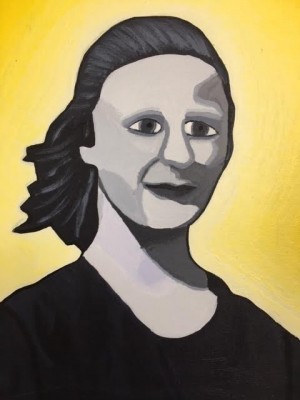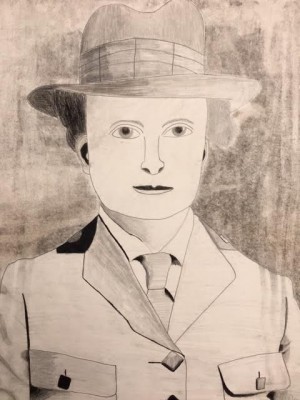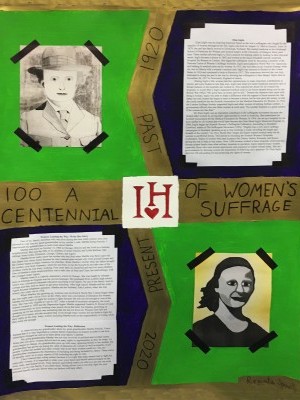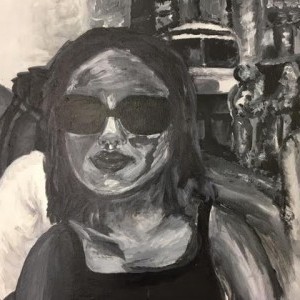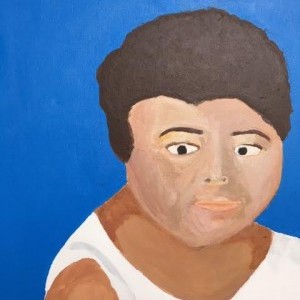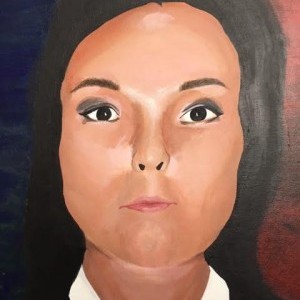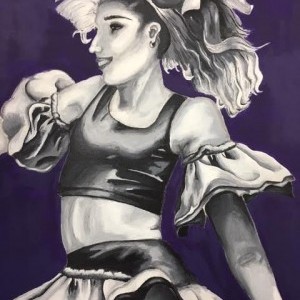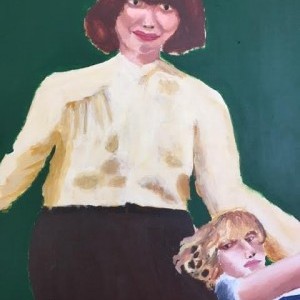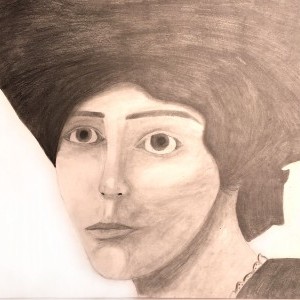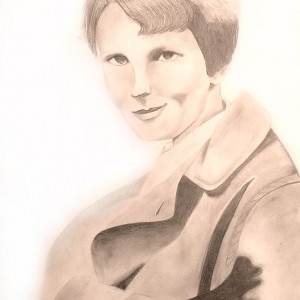Renata Spinelli
Immaculate Heart High School | Los Angeles, CA | 9-12th Grade
Inspirational Family Member
Great-Grandmother Martha
One of my family members who was alive during the time when women were first allowed to vote was my great-grandmother on my mother’s side, Martha Emma Paulick. I interviewed my grandmother to learn more about Martha.
Martha was born on October 31, 1906 in Chicago, Illinois and she lived in a German neighborhood. She was the fifth of six children of Anton Paulick and Lydia Bielfuss. Her siblings were Lydia, Elizabeth, George, Charles, and Agnes. Martha never really knew her mother who had died when Martha was three years old. Her father was rarely home because he was a stained-glass artisan who went around Europe and the United States to make windows for churches. When Martha’s mother died, her father brought his mother over from Germany, where he was born, to run the household and take care of the children while he was away working. Four years later, he remarried and had two more children.
One of Martha’s main responsibilities was to take care of John and Clara, her half-siblings, with her younger sister Agnes. Martha went to a Catholic elementary school in Chicago. She was taught by German nuns in German so English was her second language. She graduated from a public high school, which was considered adequate education according to her family. No one in her family went to college and they had no desire to get more schooling. After high school, Martha and her sister Agnes became telephone operators. Martha met her husband, John Lucken, when she was twenty-two years old in 1928.
When Martha was growing up, America was involved in World War I which began when she was eight years old in 1914. In the 1920s, there was a movement of liberation for women. Martha did not have to fight for women’s rights because she was not old enough to vote at the time. She was only eligible to vote in 1927. After a decade of economic prosperity, the stock market crashed in 1929 and the Depression began. Martha supported Franklin D. Roosevelt and voted Democratic as most working-class people did at that time. For Martha, protesting or speaking up for her beliefs was something that she did not focus on. Women were still not thought of as equal, and she accepted that. Even though many women did not think to fight for their rights at the time, many women including Martha took on the responsibility of voting when they were old enough.
Historical Figure I Admire
Elsie Inglis
Elsie Inglis was an inspiring historical figure as she was a suffragette who fought for the equality of women throughout her life. Inglis was born on August 16, 1864 in Nainital, India. In 1878, she and her family moved to Edinburgh, Scotland. She studied medicine at the Edinburgh School of Medicine for Women and studied surgery at the University of Glasgow three years later. These studies allowed Inglis to find a passion for helping others by tending to their physical needs. Inglis became a doctor in 1892 and worked at the future Elizabeth Garrett Anderson Hospital for Women in London. She began her suffragette work by becoming a member of the National Union of Women’s Suffrage Societies. Inglis participated in World War I by organizing and helping in medical units run by women. In 1915, she was taken as an Austrian hostage when she was in Siberia with a women’s medical unit. Inglis was returned to Britain by the United States in 1916 and continued to help in Russia in 1917. This experience showed she was truly dedicated to doing her part in the war by showing her willingness to face danger. Inglis died on November 26, 1917 in Newcastle, England, of cancer.
During Inglis’s life, women had few opportunities to make important contributions to society and were treated as less than men. Inglis had observed unfair treatment and poor care of female patients in the hospitals she worked in. This inspired her desire for all women-run hospitals. In world War I, Inglis organized medical units to aid forces despite being told by the British War Office “My good lady, go home and sit still.” Despite the obstacles that came with being a woman, Inglis was able to make a difference with the support of those around her. Her father not only helped her begin to train to become a doctor, but he also gave her money so that she could establish the the Scottish Association for the Medical Education for Women. In 1916, the London Suffrage Society supported Inglis and other women in helping Serbian soldiers. A government official who saw these women at work said, “No wonder England is a great country if the women are like that.”
Dr. Elsie Inglis was an important contributor to the Suffragette Movement because she helped other women by giving them opportunities to work in medicine. She established the Scottish Association for the Medical Education for Women. In 1904, she set up a hospital for the poor staffed by all women that would later become the Elsie Maud Inglis Memorial Hospital. In 1906, Inglis began the Scottish Women’s Suffragette Federation. According to Elizabeth Crawford, author of The Suffragette Movement (1999), “[Inglis] was a very active suffrage campaigner in Scotland, speaking at up to four meetings a week, travelling the length and breadth of the country.”
In 1914, World War I began and Inglis wanted medical units run by women to aid British forces. This led her to founding the Scottish Women’s Hospitals Committee. Teams of women were sent to places like France, Serbia, Romania, and Russia during the war to help in war zones. Over 1,000 women worked in these hospitals which had less disease-related deaths than other military hospitals in operation. Inglis inspired many women, especially those who were doctors and nurses, and continues to inspire women today. She set a good example by showing women the importance of following one’s passions. Dr. Elsie Inglis spent her life advocating for and protecting the rights of women.
SOURCES +
What the Project Means to Me
In interviewing my grandmother about my great-grandmother Martha Paulick, I have learned that it is very important to connect family experiences to history in order to see how times have changed as well as to learn about your family’s identity.
My great-grandmother Martha was not very involved in political and societal issues. When she was alive, women did not have as many rights or opportunities as they do today. As times began to change, my grandmother grew up with many opposing beliefs to her mother’s.
My grandmother has grown up seeing the value of education for women as well as equality of all people. Unlike her mother and other women who lived when women could not vote, my grandmother emphasizes the importance of including and being included by others. These views of equality carry on many aspects of life including the right to vote. I have learned that voting matters because it is a right that many people had to fight for, especially women. It is important to make your voice heard and beliefs acknowledged on the local, state, and federal levels. Your opinions and beliefs make you who you are and can even connect you to your family if you share them. Voting allows you to not only fight for your personal benefit, but also shows what you believe will help others.
Explore the Archive
More From This Class
Click on the thumbnails below to view each student's work.Deadline Extended
There's still time to join Women Leading the Way.
Become a part of our storytelling archive. Enroll your class today.
Join the Project

